Effects of different mycotoxins on humans, cell genome and their involvement in cancer (Review)
- Authors:
- Mowaffaq Adam Ahmed Adam
- Yasser M. Tabana
- Khirun Binti Musa
- Doblin Anak Sandai
-
Affiliations: Infectomics Cluster, Advanced Medical and Dental Institute, Universiti Sains Malaysia, Penang, Malaysia - Published online on: February 6, 2017 https://doi.org/10.3892/or.2017.5424
- Pages: 1321-1336
This article is mentioned in:
Abstract
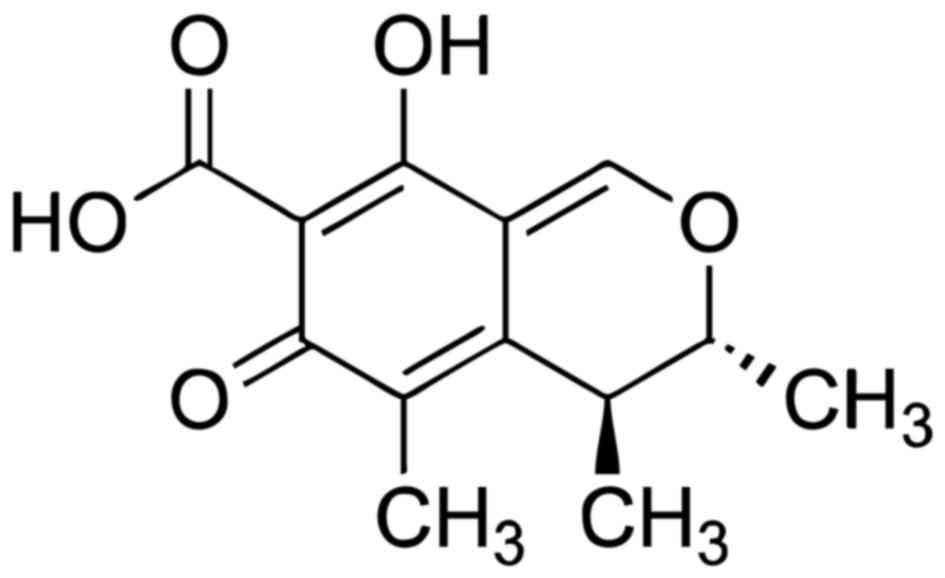 |
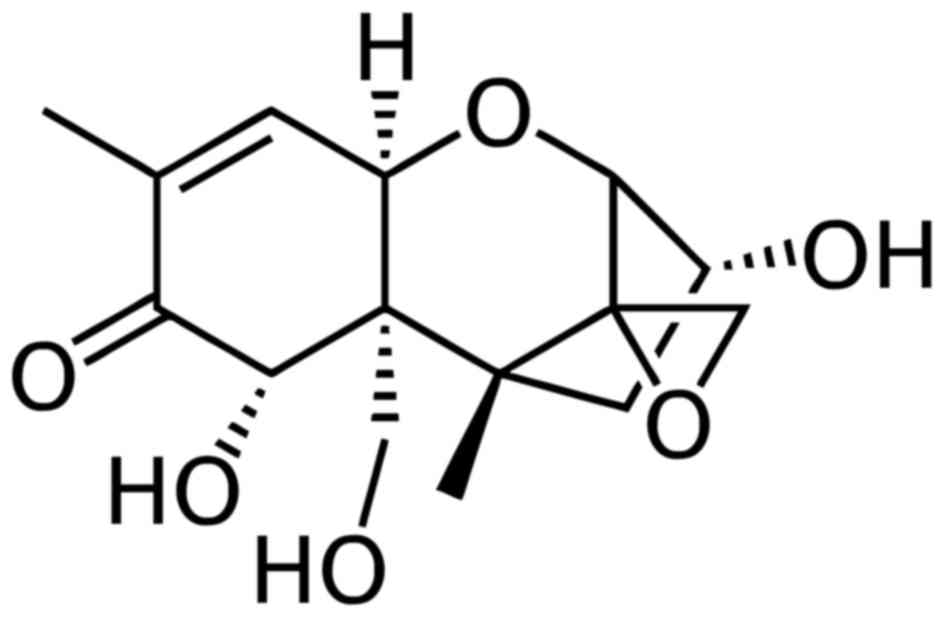 |
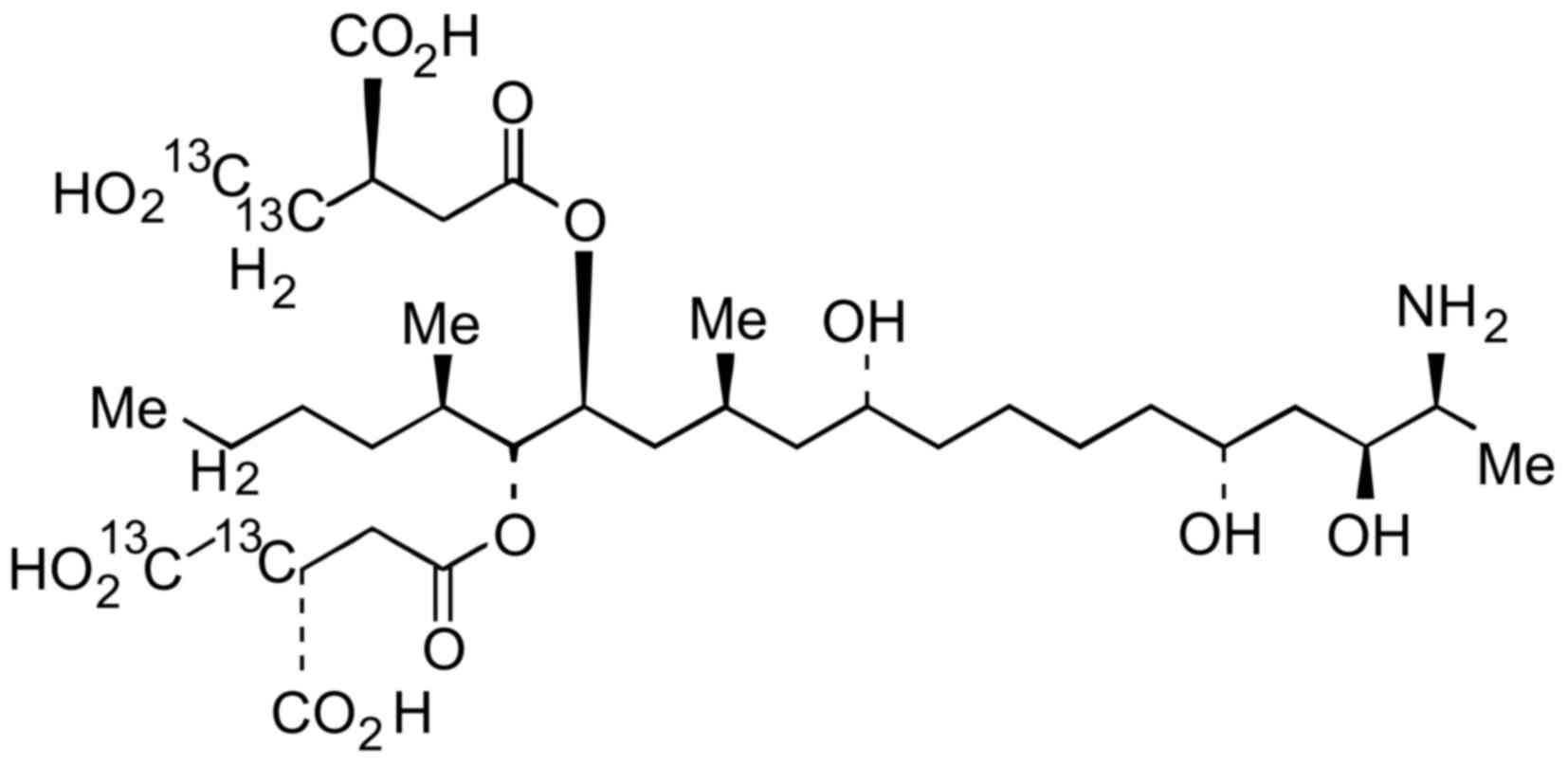 |
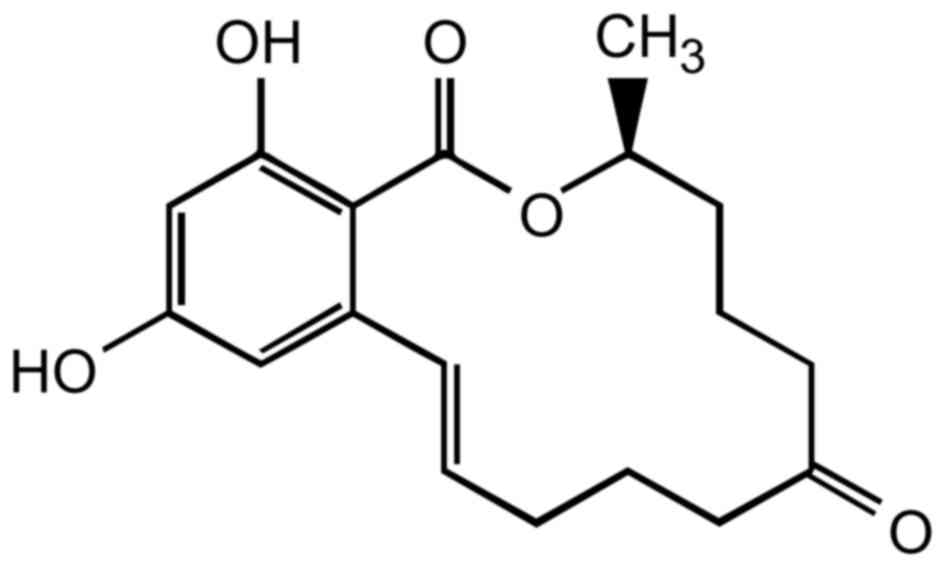 |
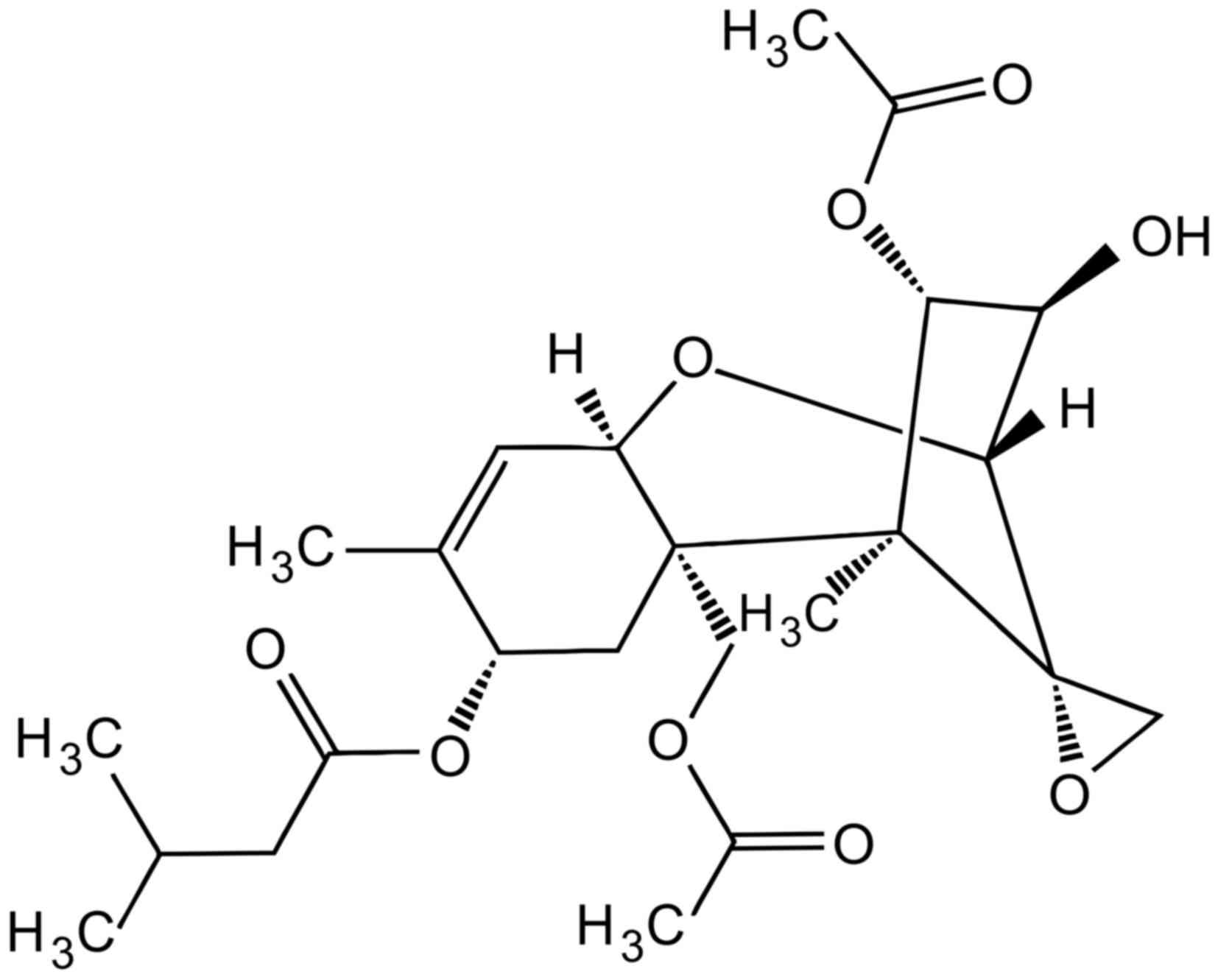 |
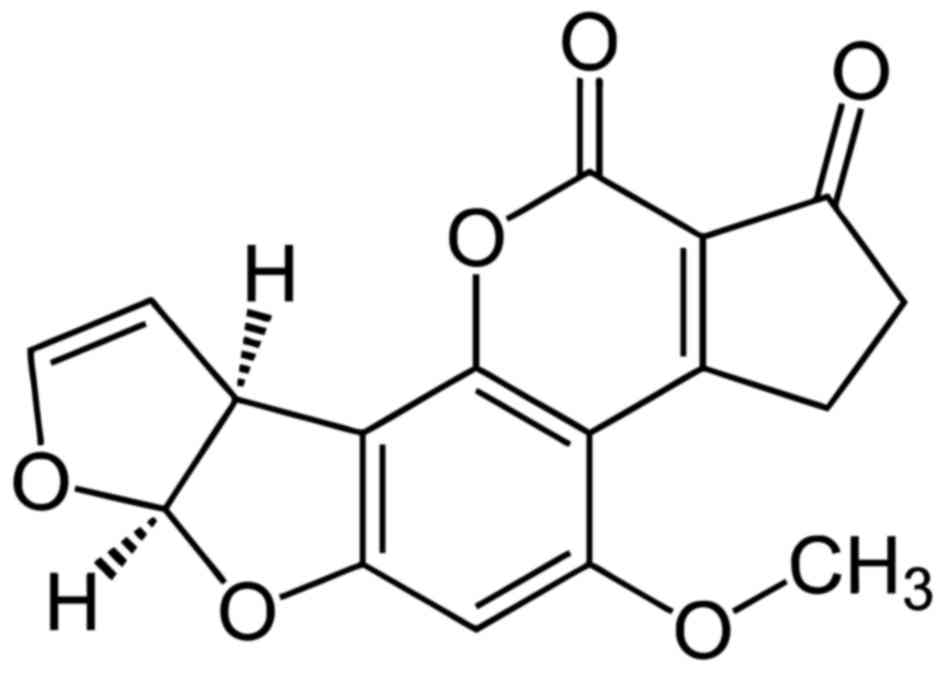 |
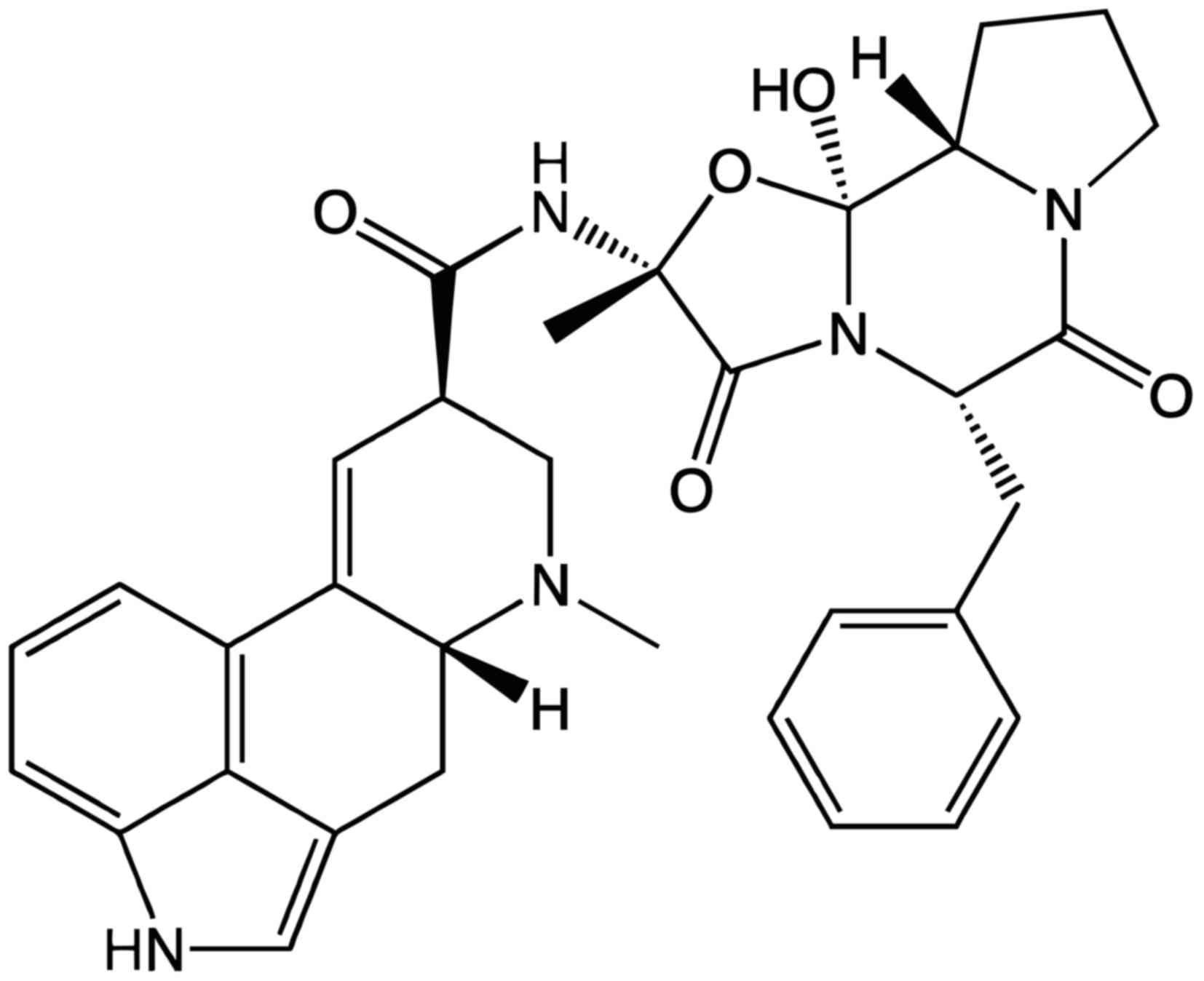 |
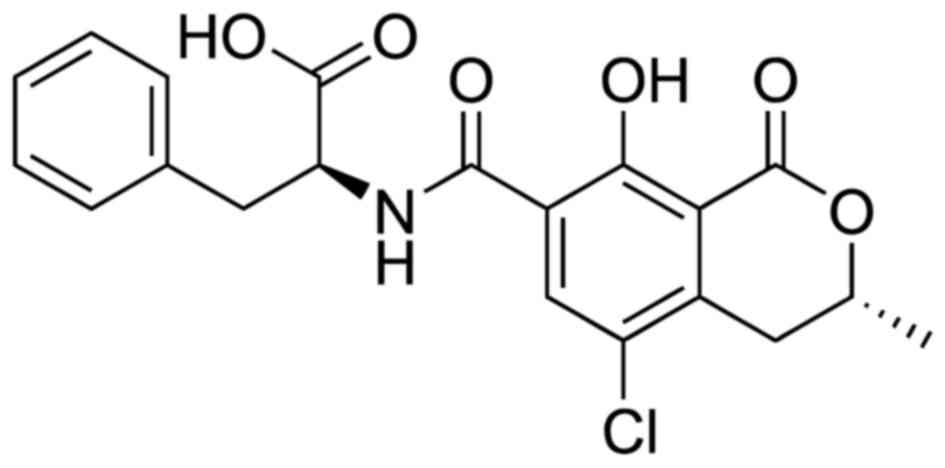 |
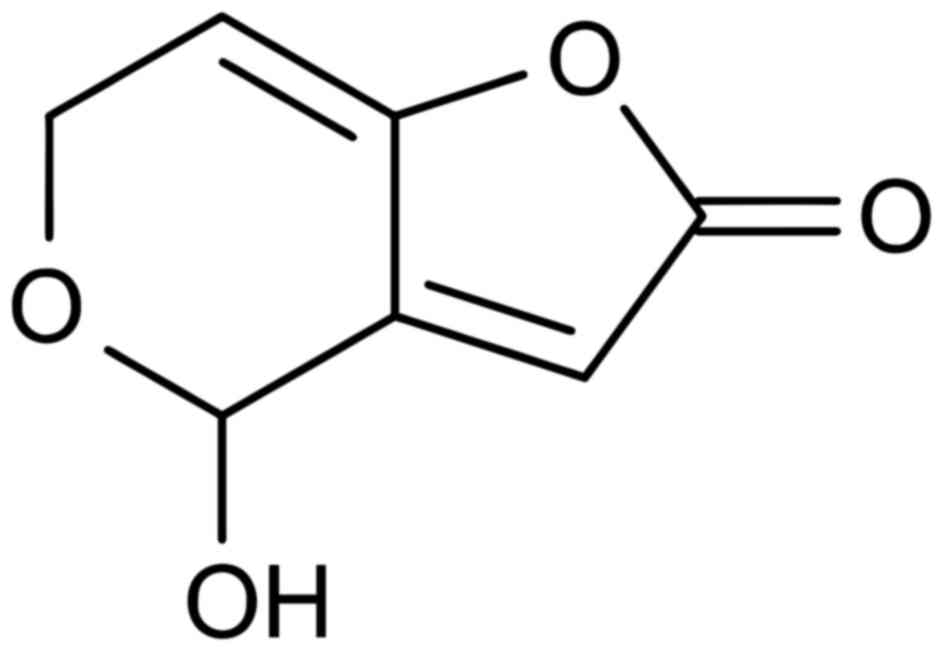 |
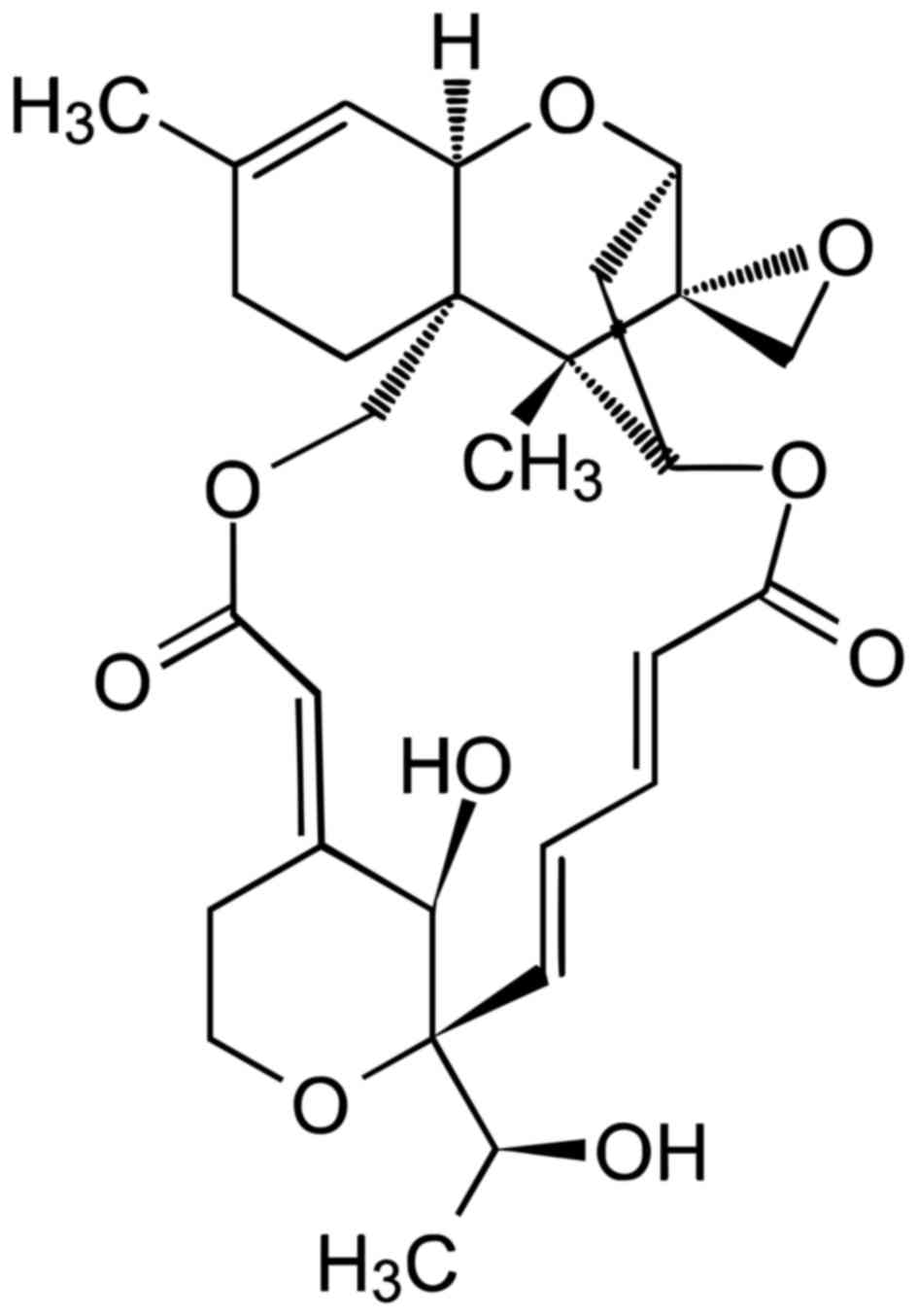 |
|
Sulaiman MR, Chye FY, Hamid AA and Yatim AM: The occurrence of aflatoxins in raw shelled peanut samples from three districts of Perak, Malaysia. Electronic Journal of Environmental and Food Chemistry. 6:2045–2052. 2007.http://eprints.ums.edu.my/3769/ | |
|
Moradi S, Azari H, Anarkoli IJ, Qasemi-Panahi B, Elhami S and Forouharmehr A: Effect of aflatoxin B1 on BRCA1 and BRCA2 genes expression under in vitro cultured cell line of normal Human Mammary Epithelial Cells (HMEC). Jan;2015.https://www.researchgate.net/publication/268226306_Effect_of_aflatoxin_B1_on_BRCA1_and_BRCA2_genes_expression_under_in_vitro_cultured_cell_line_of_normal_Human_Mammary_Epithelial_Cells_HMEC | |
|
Bbosa GS, Kitya D, Lubega A, Ogwal-Okeng J, Anokbonggo WW and Kyegombe DB: Review of the biological and health effects of aflatoxins on body organs and body systems. Aflatoxins - Recent Advances and Future Prospects. Razzaghi-Abyaneh M: InTech. doi: 10.5772/51201. | |
|
Mohd-Redzwan S, Jamaluddin R, Abd-Mutalib MS and Ahmad Z: A mini review on aflatoxin exposure in Malaysia: Past, present and future. Front Microbiol. 4:3342013. View Article : Google Scholar : PubMed/NCBI | |
|
El-banna AA, Pitt J and Leistner L: Production of mycotoxins by Penicillium species. Syst Appl Microbiol. 10:42–46. 1987.doi: 10.1016/S0723-2020(87)80008–5. View Article : Google Scholar | |
|
Frisvad JC, Filtenborg O and Thrane U: Analysis and screening for mycotoxins and other secondary metabolites in fungal cultures by thin-layer chromatography and high-performance liquid chromatography. Arch Environ Contam Toxicol. 18:331–335. 1989. View Article : Google Scholar : PubMed/NCBI | |
|
Lin L, Zhang J, Wang P, Wang Y and Chen J: Thin-layer chromatography of mycotoxins and comparison with other chromatographic methods. J Chromatogr A. 815:3–20. 1998. View Article : Google Scholar : PubMed/NCBI | |
|
van der Gaag B, Spath S, Dietrich H, Stigter E, Boonzaaijer G, van Osenbruggen T and Koopal K: Biosensors and multiple mycotoxin analysis. Food Control. 14:251–254. 2003. View Article : Google Scholar | |
|
Butler WH, Greenblatt M and Lijinsky W: Carcinogenesis in rats by aflatoxins B1, G1, and B2. Cancer Res. 29:2206–2211. 1969.PubMed/NCBI | |
|
Creppy EE: Update of survey, regulation and toxic effects of mycotoxins in Europe. Toxicol Lett. 127:19–28. 2002. View Article : Google Scholar : PubMed/NCBI | |
|
Ghoshal AK and Farber E: The induction of liver cancer by dietary deficiency of choline and methionine without added carcinogens. Carcinogenesis. 5:1367–1370. 1984. View Article : Google Scholar : PubMed/NCBI | |
|
Kensler TW, Egner PA, Davidson NE, Roebuck BD, Pikul A and Groopman JD: Modulation of aflatoxin metabolism, aflatoxin-N7-guanine formation, and hepatic tumorigenesis in rats fed ethoxyquin: Role of induction of glutathione S-transferases. Cancer Res. 46:3924–3931. 1986.PubMed/NCBI | |
|
Davis ND, Diener UL and Eldridge DW: Production of aflatoxins B1 and G1 by Aspergillus flavus in a semisynthetic medium. Appl Microbiol. 14:378–380. 1966.PubMed/NCBI | |
|
Dorner JW, Cole RJ and Diener UL: The relationship of Aspergillus flavus and Aspergillus parasiticus with reference to production of aflatoxins and cyclopiazonic acid. Mycopathologia. 87:13–15. 1984. View Article : Google Scholar : PubMed/NCBI | |
|
Farag RS, Daw ZY and Abo-Raya SH: Influence of some spice essential oils on Aspergillus parasiticus growth and production of aflatoxins in a synthetic medium. J Food Sci. 54:74–76. 1989.doi: 10.1111/j.1365-2621.1989.tb08571.x. View Article : Google Scholar | |
|
Mateles RI and Adye JC: Production of aflatoxins in submerged culture. Appl Microbiol. 13:208–211. 1965.PubMed/NCBI | |
|
Chu FS: Mycotoxins: food contamination, mechanism, carcinogenic potential and preventive measures. Mutat Res. 259:291–306. 1991.doi: 10.1016/0165-1218(91)90124–5. View Article : Google Scholar : PubMed/NCBI | |
|
Jelinek CF, Pohland AE and Wood GE: Worldwide occurrence of mycotoxins in foods and feeds - an update. J Assoc Off Anal Chem. 72:223–230. 1989.PubMed/NCBI | |
|
Krogh P: Mycotoxins in food. Academic Press Ltd.; London: 1987 | |
|
Wang J and Liu XM: Contamination of aflatoxins in different kinds of foods in China. Biomed Environ Sci. 20:483–487. 2007.PubMed/NCBI | |
|
Rustom IY: Aflatoxin in food and feed: Occurrence, legislation and inactivation by physical methods. Food Chem. 59:57–67. 1997. View Article : Google Scholar | |
|
Tabata S, Kamimura H, Ibe A, Hashimoto H, Iida M, Tamura Y and Nishima T: Aflatoxin contamination in foods and foodstuffs in Tokyo: 1986–1990. J AOAC Int. 76:32–35. 1993.PubMed/NCBI | |
|
Lane KS: Aflatoxin, tobacco, ammonia and the p53 tumor-suppressor gene: Cancer's missing link? MedGenMed. 1:E101999. | |
|
Hill RA, Blankenship PD, Cole RJ and Sanders TH: Effects of soil moisture and temperature on preharvest invasion of peanuts by the Aspergillus flavus group and subsequent aflatoxin development. Appl Environ Microbiol. 45:628–633. 1983.PubMed/NCBI | |
|
Desjardins AE: Fusarium mycotoxins: chemistry, genetics, and biologyAmerican Phytopathological Society. APS Press; St. Paul, MN: 2006 | |
|
Placinta C, D'mello J and Macdonald A: A review of worldwide contamination of cereal grains and animal feed with Fusarium mycotoxins. Anim Feed Sci Technol. 78:21–37. 1999. View Article : Google Scholar | |
|
Richard JL: Some major mycotoxins and their mycotoxicoses - an overview. Int J Food Microbiol. 119:3–10. 2007. View Article : Google Scholar : PubMed/NCBI | |
|
Gelderblom WC, Jaskiewicz K, Marasas WF, Thiel PG, Horak RM, Vleggaar R and Kriek NP: Fumonisins - novel mycotoxins with cancer-promoting activity produced by Fusarium moniliforme. Appl Environ Microbiol. 54:1806–1811. 1988.PubMed/NCBI | |
|
Sydenham EW, Shephard GS, Thiel PG, Stockenström S, Snijman PW and Van Schalkwyk DJ: Liquid chromatographic determination of fumonisins B1, B2, and B3 in corn: AOAC-IUPAC Collaborative Study. J AOAC Int. 79:688–696. 1996.PubMed/NCBI | |
|
Gimeno A: Thin layer chromatographic determination of aflatoxins, ochratoxins, sterigmatocystin, zearalenone, citrinin, T-2 toxin, diacetoxyscirpenol, penicillic acid, patulin, and penitrem A. J Assoc Off Anal Chem. 62:579–585. 1979.PubMed/NCBI | |
|
Petzinger E and Weidenbach A: Mycotoxins in the food chain: The role of ochratoxins. Livest Prod Sci. 76:245–250. 2002. View Article : Google Scholar | |
|
Trenk HL, Butz ME and Chu FS: Production of ochratoxins in different cereal products by Aspergillus ochraceus. Appl Microbiol. 21:1032–1035. 1971.PubMed/NCBI | |
|
Cavin C, Delatour T, Marin-Kuan M, Holzhäuser D, Higgins L, Bezençon C, Guignard G, Junod S, Richoz-Payot J, Gremaud E, et al: Reduction in antioxidant defenses may contribute to Ochratoxin A toxicity and carcinogenicity. Toxicol Sci. 96:30–39. 2007. View Article : Google Scholar : PubMed/NCBI | |
|
Fink-Gremmels J, Jahn A and Blom MJ: Toxicity and metabolism of Ochratoxin A. Nat Toxins. 3:214–220, discussion 221. 1995. View Article : Google Scholar : PubMed/NCBI | |
|
Rahimtula AD, Béréziat J-C, Bussacchini-Griot V and Bartsch H: Lipid peroxidation as a possible cause of Ochratoxin A toxicity. Biochem Pharmacol. 37:4469–4477. 1988. View Article : Google Scholar : PubMed/NCBI | |
|
Battilani P, Giorni P and Pietri A: Epidemiology of toxin-producing fungi and Ochratoxin A occurrence in grapeEpidemiology of Mycotoxin Producing Fungi. Springer; pp. 715–722. 2003, doi: 10.1007/978-94-017-1452-5_6. View Article : Google Scholar | |
|
Czerwiecki L, Czajkowska D and Witkowska-Gwiazdowska A: On Ochratoxin A and fungal flora in Polish cereals from conventional and ecological farms. Part 2: Occurrence of Ochratoxin A and fungi in cereals in 1998. Food Addit Contam. 19:1051–1057. 2002. View Article : Google Scholar : PubMed/NCBI | |
|
Duarte SC, Pena A and Lino CM: A review on Ochratoxin A occurrence and effects of processing of cereal and cereal derived food products. Food Microbiol. 27:187–198. 2010. View Article : Google Scholar : PubMed/NCBI | |
|
Shotwell OL, Hesseltine CW and Goulden ML: Ochratoxin A: Occurrence as natural contaminant of a corn sample. Appl Microbiol. 17:765–766. 1969.PubMed/NCBI | |
|
López-García R: Mycotoxin management: an international challengeEnsuring Global Food Safety: Exploring Global Harmonization. Boisrobert C, et al: Elsevier; pp. 209–216. 2009 | |
|
Bennett JW and Klich M: Mycotoxins. Clin Microbiol Rev. 16:497–516. 2003.doi: 10.1128/CMR.16.3.497-516.2003. View Article : Google Scholar : PubMed/NCBI | |
|
Squire RA: Ranking animal carcinogens: A proposed regulatory approach. Science. 214:877–880. 1981. View Article : Google Scholar : PubMed/NCBI | |
|
Goto T, Wicklow DT and Ito Y: Aflatoxin and cyclopiazonic acid production by a sclerotium-producing Aspergillus tamarii strain. Appl Environ Microbiol. 62:4036–4038. 1996.PubMed/NCBI | |
|
Klich MA, Mullaney EJ, Daly CB and Cary JW: Molecular and physiological aspects of aflatoxin and sterigmatocystin biosynthesis by Aspergillus tamarii and A. ochraceoroseus. Appl Microbiol Biotechnol. 53:605–609. 2000. View Article : Google Scholar : PubMed/NCBI | |
|
Peterson SW, Ito Y, Horn BW and Goto T: Aspergillus bombycis, a new aflatoxigenic species and genetic variation in its sibling species, A. nomius. Mycologia. 93:689–703. 2001. View Article : Google Scholar | |
|
Heathcote JG and Hibbert J: Aflatoxins: Chemical and Biological aspects. Elsevier Scientific Publishing Co.; Amsterdam: 1978 | |
|
Bennett JW, Chang PK and Bhatnagar D: One gene to whole pathway: The role of norsolorinic acid in aflatoxin research. Adv Appl Microbiol. 45:1–15. 1997. View Article : Google Scholar : PubMed/NCBI | |
|
Cleveland TE and Bhatnagar D: Molecular strategies for reducing aflatoxin levels in crops before harvestMolecular Approaches to Improving Food Quality and Safety. Springer; pp. 205–228. 1992, doi: 10.1007/978-1-4684-8070-2_9. View Article : Google Scholar | |
|
Hicks JK, Shimizu K and Keller NP: Genetics and biosynthesis of aflatoxins and sterigmatocystin. The Mycota XIAgricultural Applications. Kempken F: Springer-Verlag; Berlin: pp. 55–69. 2002, View Article : Google Scholar | |
|
Payne GA and Brown MP: Genetics and physiology of aflatoxin biosynthesis. Annu Rev Phytopathol. 36:329–362. 1998. View Article : Google Scholar : PubMed/NCBI | |
|
Townsend C: Progress toward a biosynthetic rationale of the aflatoxin pathway. Pure Appl Chem. 58:227–238. 1986. View Article : Google Scholar | |
|
Trail F, Mahanti N and Linz J: Molecular biology of aflatoxin biosynthesis. Microbiology. 141:755–765. 1995. View Article : Google Scholar : PubMed/NCBI | |
|
Hackbart H, Prietto L, Primel EG, Garda-Buffon J and Badiale-Furlong E: Simultaneous extraction and detection of Ochratoxin A and citrinin in rice. J Braz Chem Soc. 23:103–109. 2012. View Article : Google Scholar | |
|
Aleo MD, Wyatt RD and Schnellmann RG: The role of altered mitochondrial function in citrinin-induced toxicity to rat renal proximal tubule suspensions. Toxicol Appl Pharmacol. 109:455–463. 1991. View Article : Google Scholar : PubMed/NCBI | |
|
Manabe M: Fermented foods and mycotoxins. J Jpn Assoc Mycotoxicol. 51:25–29. 2001. View Article : Google Scholar | |
|
Carlton WW and Tuite J: Metabolites of P. viridicatum toxicologyMycotoxins in Human and Animal Health. Mehlman MA: Pathotox Publications, Inc.; Park Forest South, IL: pp. 525–555. 1977 | |
|
Saito M, Enomoto M, Tatsuno T and Uraguchi K: Yellowed Rice Toxins: Luteoskyrin and Related Compounds, Chlorine-Containing Compounds, and Citrinin. Ajl, Samuel J Microb Toxins. 1971. | |
|
Richard JL: Mycotoxins - an overview. Romer Labs' Guide To Mycotoxins. 2012. | |
|
Bennett J and Bentley R: Pride and prejudice: The story of ergot. Perspect Biol Med. 42:333–355. 1999. View Article : Google Scholar | |
|
Sweeney MJ and Dobson AD: Molecular biology of mycotoxin biosynthesis. FEMS Microbiol Lett. 175:149–163. 1999. View Article : Google Scholar : PubMed/NCBI | |
|
Lia Y, Lou L, Cerny RL, Butchko RA, Proctor RH, Shen Y and Du L: Tricarballylic ester formation during biosynthesis of fumonisin mycotoxins in Fusarium verticillioides. Mycology. 4:179–186. 2013. View Article : Google Scholar : PubMed/NCBI | |
|
Van der Merwe KJ, Steyn PS, Fourie L, Scott DB and Theron JJ: Ochratoxin A, a toxic metabolite produced by Aspergillus ochraceus Wilh. Nature. 205:1112–1113. 1965. View Article : Google Scholar : PubMed/NCBI | |
|
Huang B, Tao W, Shi J, Tang L and Jin J: Determination of Ochratoxin A by polyclonal antibodies based sensitive time-resolved fluoroimmunoassay. Arch Toxicol. 80:481–485. 2006. View Article : Google Scholar : PubMed/NCBI | |
|
Ciegler A, Detroy RW and Lillehoj EB: Patulin, penicillic acid, and other carcinogenic lactonesMicrobial Toxins. Ciegler A, Kadis S and Ajl SJ: 6. Academic Press; New York: pp. 409–434. 1971 | |
|
Sekiguchi J and Gaucher GM: Identification of phyllostine as an intermediate of the patulin pathway in Penicillium urticae. Biochemistry. 17:1785–1791. 1978. View Article : Google Scholar : PubMed/NCBI | |
|
Cole RJ and Cox RH: The trichothecenesHandbook of Toxic Fungal Metabolites. Academic Press; New York: pp. 152–263. 1981, View Article : Google Scholar | |
|
Scott PM: The natural occurrence of trichothecenesTrichothecene mycotoxicosis: Pathophysiologic effects. Beasley VR: 1. CRC Press; Boca Raton, FL: pp. 1–26. 1989 | |
|
Ueno Y: TrichothecenesChemical, Biological and Toxicological Aspects. Elsevier; Amsterdam: 1983 | |
|
Marasas WFO, Nelson PE and Toussoun TA: Toxigenic Fusarium speciesIdentity and mycotoxicology. University Park: Pennsylvania State University Press; 1984 | |
|
Hinkley SF and Jarvis BB: 15 Chromatographic method for Stachybotrys toxinsMycotoxin Protocols. 157. Humana Press; pp. 173–194. 2001, View Article : Google Scholar | |
|
Urry W, Wehrmeister H, Hodge E and Hidy P: The structure of zearalenone. Tetrahedron Lett. 7:3109–3114. 1966. View Article : Google Scholar | |
|
Cousin MA, Riley RT and Pestka JJ: Foodborne Mycotoxins: Chemistry, Biology, Ecology, and Toxicology. Caister Academic Press; Norfolk: 2005 | |
|
Bullerman LB and Bianchini A: Stability of mycotoxins during food processing. Int J Food Microbiol. 119:140–146. 2007. View Article : Google Scholar : PubMed/NCBI | |
|
Visconti A and Pascale M: REVIEW: An overview on Fusarium mycotoxins in the durum wheat pasta production chain. Cereal Chem. 87:21–27. 2010. View Article : Google Scholar | |
|
Kabak B: The fate of mycotoxins during thermal food processing. J Sci Food Agric. 89:549–554. 2009. View Article : Google Scholar | |
|
Scott P: Effects of food processing on mycotoxins. J Food Prot. 47:489–499. 1984. View Article : Google Scholar | |
|
Doyle M, Applebaum R, Brackett R and Marth E: Physical, chemical and biological degradation of mycotoxins in foods and agricultural commodities. J Food Prot. 45:964–971. 1982. View Article : Google Scholar | |
|
Lauren DR and Smith WA: Stability of the fusarium mycotoxins nivalenol, deoxynivalenol and zearalenone in ground maize under typical cooking environments. Food Addit Contam. 18:1011–1016. 2001. View Article : Google Scholar : PubMed/NCBI | |
|
Gund P: Guanidine, trimethylenemethane, and Y-delocalization. Can acyclic compounds have aromatic stability? J Chem Educ. 49:1001972. | |
|
Silverstein RM and Bassler GC: Spectrometric identification of organic compounds. J Chem Educ. 39:5461962. View Article : Google Scholar | |
|
Abbas HK: Aflatoxin and Food Safety. CRC Press; 2005, doi: 10.1201/9781420028171. View Article : Google Scholar | |
|
Jarvis BB and Miller JD: Mycotoxins as harmful indoor air contaminants. Appl Microbiol Biotechnol. 66:367–372. 2005. View Article : Google Scholar : PubMed/NCBI | |
|
Serra R, Braga A and Venâncio A: Mycotoxin-producing and other fungi isolated from grapes for wine production, with particular emphasis on Ochratoxin A. Res Microbiol. 156:515–521. 2005. View Article : Google Scholar : PubMed/NCBI | |
|
Agag B: Mycotoxins in foods and feeds: 1-aflatoxins. Assiut Univ Bull Environ Res. 7:173–205. 2004. | |
|
Eaton DL and Groopman JD: Toxicology of Aflatoxins: Human Health, Veterinary, and Agricultural Significance. Elsevier; 2013 | |
|
He XY, Tang L, Wang SL, Cai QS, Wang JS and Hong JY: Efficient activation of aflatoxin B1 by cytochrome P450 2A13, an enzyme predominantly expressed in human respiratory tract. Int J Cancer. 118:2665–2671. 2006. View Article : Google Scholar : PubMed/NCBI | |
|
Baertschi SW, Raney KD, Stone MP and Harris TM: Preparation of the 8, 9-epoxide of the mycotoxin aflatoxin B1: The ultimate carcinogenic species. J Am Chem Soc. 110:7929–7931. 1988. View Article : Google Scholar | |
|
Yates MS, Kwak M-K, Egner PA, Groopman JD, Bodreddigari S, Sutter TR, Baumgartner KJ, Roebuck BD, Liby KT, Yore MM, et al: Potent protection against aflatoxin-induced tumorigenesis through induction of Nrf2-regulated pathways by the triterpenoid 1-[2-cyano-3-,12-dioxooleana-1,9(11)-dien-28-oyl]imidazole. Cancer Res. 66:2488–2494. 2006. View Article : Google Scholar : PubMed/NCBI | |
|
Boorman GA, McDonald MR, Imoto S and Persing R: Renal lesions induced by Ochratoxin A exposure in the F344 rat. Toxicol Pathol. 20:236–245. 1992. View Article : Google Scholar : PubMed/NCBI | |
|
Chu Y-M, Jeon J-J, Yea S-J, Kim Y-H, Yun S-H, Lee Y-W and Kim KH: Double-stranded RNA mycovirus from Fusarium graminearum. Appl Environ Microbiol. 68:2529–2534. 2002. View Article : Google Scholar : PubMed/NCBI | |
|
Kuiper-Goodman T and Scott PM: Risk assessment of the mycotoxin Ochratoxin A. Biomed Environ Sci. 2:179–248. 1989.PubMed/NCBI | |
|
Bunge I, Heller K and Röschenthaler R: Isolation and purification of Ochratoxin A. Zeitschrift fürLebensmitteluntersuchung und-Forschung. 168:457–458. 1979.doi: 10.1007/BF01479260. View Article : Google Scholar | |
|
Marquardt RR and Frohlich AA: A review of recent advances in understanding ochratoxicosis. J Anim Sci. 70:3968–3988. 1992. View Article : Google Scholar : PubMed/NCBI | |
|
Meisner H and Meisner P: Ochratoxin A, an in vivo inhibitor of renal phosphoenolpyruvate carboxykinase. Arch Biochem Biophys. 208:146–153. 1981. View Article : Google Scholar : PubMed/NCBI | |
|
Rocha O, Ansari K and Doohan FM: Effects of trichothecene mycotoxins on eukaryotic cells: A review. Food Addit Contam. 22:369–378. 2005. View Article : Google Scholar : PubMed/NCBI | |
|
Desmond OJ, Manners JM, Stephens AE, Maclean DJ, Schenk PM, Gardiner DM, Munn AL and Kazan K: The Fusarium mycotoxin deoxynivalenol elicits hydrogen peroxide production, programmed cell death and defence responses in wheat. Mol Plant Pathol. 9:435–445. 2008. View Article : Google Scholar : PubMed/NCBI | |
|
Pestka JJ: Deoxynivalenol-induced IgA production and IgA nephropathy-aberrant mucosal immune response with systemic repercussions. Toxicol Lett. 140–141, 287–295. 2003. | |
|
Bunner DL and Morris ER: Alteration of multiple cell membrane functions in L-6 myoblasts by T-2 toxin: An important mechanism of action. Toxicol Appl Pharmacol. 92:113–121. 1988. View Article : Google Scholar : PubMed/NCBI | |
|
Diamond M, Reape TJ, Rocha O, Doyle SM, Kacprzyk J, Doohan FM and McCabe PF: The fusarium mycotoxin deoxynivalenol can inhibit plant apoptosis-like programmed cell death. PLoS One. 8:e695422013. View Article : Google Scholar : PubMed/NCBI | |
|
Hansen B: Inhibition of protein synthesis by trichothecenesMycotoxins in Human and Animal Health. Meky FA, Hardie LJ, Evans SW and Wild CP: Pathotox Publications; Park Forest South, IL: pp. 263–273. 2001 | |
|
Thompson WL and Wannemacher RW Jr: Detection and quantitation of T-2 mycotoxin with a simplified protein synthesis inhibition assay. Appl Environ Microbiol. 48:1176–1180. 1984.PubMed/NCBI | |
|
Wannemacher RW, Wiener SL, Sidell FR, Takafuji ET and Franz DR: Trichothecene mycotoxins. Medical Aspects of Chemical and Biological Warfare. 655–676. 1997. | |
|
Yang G-H, Jarvis BB, Chung Y-J and Pestka JJ: Apoptosis induction by the satratoxins and other trichothecene mycotoxins: Relationship to ERK p38 MAPK, and SAPK/JNK activation. Toxicol Appl Pharmacol. 164:149–160. 2000. View Article : Google Scholar : PubMed/NCBI | |
|
Zhou H-R, Islam Z and Pestka JJ: Rapid, sequential activation of mitogen-activated protein kinases and transcription factors precedes proinflammatory cytokine mRNA expression in spleens of mice exposed to the trichothecene vomitoxin. Toxicol Sci. 72:130–142. 2003. View Article : Google Scholar : PubMed/NCBI | |
|
Sansing GA, Lillehoj EB, Detroy RW and Miller MA: Synergistic toxic effects of citrinin, Ochratoxin A and penicillic acid in mice. Toxicon. 14:213–220. 1976. View Article : Google Scholar : PubMed/NCBI | |
|
Wichmann G, Herbarth O and Lehmann I: The mycotoxins citrinin, gliotoxin, and patulin affect interferon-γ rather than interleukin-4 production in human blood cells. Environ Toxicol. 17:211–218. 2002. View Article : Google Scholar : PubMed/NCBI | |
|
Dönmez-Altuntas H, Dumlupinar G, Imamoglu N, Hamurcu Z and Liman BC: Effects of the mycotoxin citrinin on micronucleus formation in a cytokinesis-block genotoxicity assay in cultured human lymphocytes. J Appl Toxicol. 27:337–341. 2007. View Article : Google Scholar : PubMed/NCBI | |
|
Flajs D and Peraica M: Toxicological properties of citrinin. Arh Hig Rada Toksikol. 60:457–464. 2009. View Article : Google Scholar : PubMed/NCBI | |
|
Bhat R, Rai RV and Karim AA: Mycotoxins in food and feed: present status and future concerns. Compr Rev Food Sci Food Saf. 9:57–81. 2010.doi: 10.1111/j.1541-4337.2009.00094.x. View Article : Google Scholar | |
|
Matossian MK: Mold poisoning: An unrecognized English health problem, 1550–1800. Med Hist. 25:73–84. 1981. View Article : Google Scholar : PubMed/NCBI | |
|
Matossian MK: Poisons of the Past: Molds, Epidemics, and History. Yale University Press; New Haven and London: 1989, Arch Nat Hist. 18. pp. 145Available online: Jul 2010. http://dx.doi.org/10.3366/anh.1991.18.1.145 | |
|
Binder EM: Managing the risk of mycotoxins in modern feed production. Anim Feed Sci Technol. 133:149–166. 2007. View Article : Google Scholar | |
|
Lorenz K and Hoseney RC: Ergot on cereal grains. Crit Rev Food Sci Nutr. 11:311–354. 1979. View Article : Google Scholar | |
|
Riddle JM: Eve's Herbs: A History of Contraception and Abortion in the West. Harvard University Press; 1999 | |
|
Caballero-Granado FJ, Viciana P, Cordero E, Gómez-Vera MJ, del Nozal M and López-Cortés LF: Ergotism related to concurrent administration of ergotamine tartrate and ritonavir in an AIDS patient. Antimicrob Agents Chemother. 41:12071997.PubMed/NCBI | |
|
Alberts JF, Gelderblom WC, Thiel PG, Marasas WF, Van Schalkwyk DJ and Behrend Y: Effects of temperature and incubation period on production of fumonisin B1 by Fusarium moniliforme. Appl Environ Microbiol. 56:1729–1733. 1990.PubMed/NCBI | |
|
Gelderblom WC, Smuts CM, Abel S, Snyman SD, Cawood ME, van der Westhuizen L and Swanevelder S: Effect of fumonisin B1 on protein and lipid synthesis in primary rat hepatocytes. Food Chem Toxicol. 34:361–369. 1996. View Article : Google Scholar : PubMed/NCBI | |
|
Pozzi CR, Corrêa B, Xavier JG, Direito GM, Orsi RB and Matarazzo SV: Effects of prolonged oral administration of fumonisin B1 and aflatoxin B1 in rats. Mycopathologia. 151:21–27. 2001. View Article : Google Scholar : PubMed/NCBI | |
|
Sydenham EW, Shephard GS, Thiel PG, Marasas WF and Stockenstrom S: Fumonisin contamination of commercial corn-based human foodstuffs. J Agric Food Chem. 39:2014–2018. 1991. View Article : Google Scholar | |
|
Kouadio JH, Mobio TA, Baudrimont I, Moukha S, Dano SD and Creppy EE: Comparative study of cytotoxicity and oxidative stress induced by deoxynivalenol, zearalenone or fumonisin B1 in human intestinal cell line Caco-2. Toxicology. 213:56–65. 2005. View Article : Google Scholar : PubMed/NCBI | |
|
Tolleson WH, Melchior WB Jr, Morris SM, McGarrity LJ, Domon OE, Muskhelishvili L, James SJ and Howard PC: Apoptotic and anti-proliferative effects of fumonisin B1 in human keratinocytes, fibroblasts, esophageal epithelial cells and hepatoma cells. Carcinogenesis. 17:239–249. 1996. View Article : Google Scholar : PubMed/NCBI | |
|
Hendricks KA, Simpson JS and Larsen RD: Neural tube defects along the Texas-Mexico border, 1993–1995. Am J Epidemiol. 149:1119–1127. 1999. View Article : Google Scholar : PubMed/NCBI | |
|
Missmer S, Hendricks K, Suarez L, Larsen R and Rothman I: Fumonisins and neural tube defects. Epidemiology. 11:183–184. 2000. | |
|
Rheeder JP, Marasas WF and Vismer HF: Production of fumonisin analogs by Fusarium species. Appl Environ Microbiol. 68:2101–2105. 2002. View Article : Google Scholar : PubMed/NCBI | |
|
Trucksess MW and Tang Y: Solid-phase extraction method for patulin in apple juice and unfiltered apple juice. J AOAC Int. 82:1109–1113. 1999.PubMed/NCBI | |
|
Stafford ME and McLaughlin CS: Trichodermin, a possible inhibitor of the termination process of protein synthesis. J Cell Physiol. 82:121–128. 1973. View Article : Google Scholar : PubMed/NCBI | |
|
Wei C-M, Campbell IM, McLaughlin CS and Vaughan MH: Letter: Binding of trichodermin to mammalian ribosomes and its inhibition by other 12,13-epoxytrichothecenes. Mol Cell Biochem. 3:215–219. 1974. View Article : Google Scholar : PubMed/NCBI | |
|
Bennett JW and Klich M: Mycotoxins. Clin Microbiol Rev. 16:497–516. 2003. View Article : Google Scholar : PubMed/NCBI | |
|
Rotter BA: Invited review: Toxicology of deoxynivalenol (vomitoxin). J Toxicol Environ Health A. 48:1–34. 1996. View Article : Google Scholar | |
|
Islam Z, Gray JS and Pestka JJ: p38 Mitogen-activated protein kinase mediates IL-8 induction by the ribotoxin deoxynivalenol in human monocytes. Toxicol Appl Pharmacol. 213:235–244. 2006. View Article : Google Scholar : PubMed/NCBI | |
|
Zain ME: Impact of mycotoxins on humans and animals. J Saudi Chem Soc. 15:129–144. 2011. View Article : Google Scholar | |
|
Ueno Y, Umemori K, Niimi E, Tanuma S, Nagata S, Sugamata M, Ihara T, Sekijima M, Kawai K, Ueno I, et al: Induction of apoptosis by T-2 toxin and other natural toxins in HL-60 human promyelotic leukemia cells. Nat Toxins. 3:129–137. 1995. View Article : Google Scholar : PubMed/NCBI | |
|
Yarom R, More R, Eldor A and Yagen B: The effect of T-2 toxin on human platelets. Toxicol Appl Pharmacol. 73:210–217. 1984. View Article : Google Scholar : PubMed/NCBI | |
|
Sudakin DL: Trichothecenes in the environment: Relevance to human health. Toxicol Lett. 143:97–107. 2003. View Article : Google Scholar : PubMed/NCBI | |
|
Lautraite S, Parent-Massin D, Rio B and Hoellinger H: Comparison of toxicity induced by T-2 toxin on human and rat granulo-monocytic progenitors with an in vitro model. Hum Exp Toxicol. 14:672–678. 1995. View Article : Google Scholar : PubMed/NCBI | |
|
Kuhn DM and Ghannoum MA: Indoor mold, toxigenic fungi, and Stachybotrys chartarum: Infectious disease perspective. Clin Microbiol Rev. 16:144–172. 2003. View Article : Google Scholar : PubMed/NCBI | |
|
Kuiper-Goodman T, Scott PM and Watanabe H: Risk assessment of the mycotoxin zearalenone. Regul Toxicol Pharmacol. 7:253–306. 1987. View Article : Google Scholar : PubMed/NCBI | |
|
Utian WH: Comparative trial of P1496, a new non-steroidal oestrogen analogue. BMJ. 1:579–581. 1973. View Article : Google Scholar : PubMed/NCBI | |
|
Shier WT, Shier AC, Xie W and Mirocha CJ: Structure-activity relationships for human estrogenic activity in zearalenone mycotoxins. Toxicon. 39:1435–1438. 2001. View Article : Google Scholar : PubMed/NCBI | |
|
Kanora A and Maes D: The role of mycotoxins in pig reproduction: a review. Vet Med Czech. 54:565–576. 2009. | |
|
Ueno Y and Kubota K: DNA-attacking ability of carcinogenic mycotoxins in recombination-deficient mutant cells of Bacillus subtilis. Cancer Res. 36:445–451. 1976.PubMed/NCBI | |
|
Uraguchi K, Saito M, Noguchi Y, Takahashi K, Enomoto M and Tatsuno T: Chronic toxicity and carcinogenicity in mice of the purified mycotoxins, luteoskyrin and cyclochlorotine. Food Cosmet Toxicol. 10:193–207. 1972. View Article : Google Scholar : PubMed/NCBI | |
|
Voss KA, Howard PC, Riley RT, Sharma RP, Bucci TJ and Lorentzen RJ: Carcinogenicity and mechanism of action of fumonisin B1: A mycotoxin produced by Fusarium moniliforme (= F. verticillioides). Cancer Detect Prev. 26:1–9. 2002. View Article : Google Scholar : PubMed/NCBI | |
|
Mori H, Kawai K, Ohbayashi F, Kuniyasu T, Yamazaki M, Hamasaki T and Williams GM: Genotoxicity of a variety of mycotoxins in the hepatocyte primary culture/DNA repair test using rat and mouse hepatocytes. Cancer Res. 44:2918–2923. 1984.PubMed/NCBI | |
|
Newberne PM: Mycotoxins: Toxicity, carcinogenicity, and the influence of various nutritional conditions. Environ Health Perspect. 9:1–32. 1974. View Article : Google Scholar : PubMed/NCBI | |
|
Gradelet S, Astorg P, Le B, on A-M, Bergès R and Suschetet M: Modulation of aflatoxin B1 carcinogenicity, genotoxicity and metabolism in rat liver by dietary carotenoids: Evidence for a protective effect of CYP1A inducers. Cancer Lett. 114:221–223. 1997. View Article : Google Scholar : PubMed/NCBI | |
|
Massey TE, Stewart RK, Daniels JM and Liu L: Biochemical and molecular aspects of mammalian susceptibility to aflatoxin B1 carcinogenicity. Proc Soc Exp Biol Med. 208:213–227. 1995. View Article : Google Scholar : PubMed/NCBI | |
|
Iyer RS, Coles BF, Raney KD, Thier R, Guengerich FP and Harris TM: DNA adduction by the potent carcinogen aflatoxin B1: Mechanistic studies. J Am Chem Soc. 116:1603–1609. 1994. View Article : Google Scholar | |
|
Johnson WW and Guengerich FP: Reaction of aflatoxin B1 exo-8,9-epoxide with DNA: Kinetic analysis of covalent binding and DNA-induced hydrolysis. Proc Natl Acad Sci USA. 94:6121–6125. 1997. View Article : Google Scholar : PubMed/NCBI | |
|
Wilson SC, Howard PW, Forrow SM, Hartley JA, Adams LJ, Jenkins TC, Kelland LR and Thurston DE: Design, synthesis, and evaluation of a novel sequence-selective epoxide-containing DNA cross-linking agent based on the pyrrolo[2,1-c][1,4]benzodiazepine system. J Med Chem. 42:4028–4041. 1999. View Article : Google Scholar : PubMed/NCBI | |
|
Hollstein M, Sidransky D, Vogelstein B and Harris CC: p53 mutations in human cancers. Science. 253:49–53. 1991. View Article : Google Scholar : PubMed/NCBI | |
|
Chen J, Goetchius MP, Campbell TC and Combs GF Jr.: Effects of dietary selenium and vitamin E on hepatic mixed-function oxidase activities and in vivo covalent binding of aflatoxin B1 in rats. J Nutr. 112:324–331. 1982.PubMed/NCBI | |
|
Peers FG and Linsell CA: Dietary aflatoxins and liver cancer - a population based study in Kenya. Br J Cancer. 27:473–484. 1973. View Article : Google Scholar : PubMed/NCBI | |
|
Aguilar F, Hussain SP and Cerutti P: Aflatoxin B1 induces the transversion of G->T in codon 249 of the p53 tumor suppressor gene in human hepatocytes. Proc Natl Acad Sci USA. 90:8586–8590. 1993. View Article : Google Scholar : PubMed/NCBI | |
|
Van Rensburg SJ, Cook-Mozaffari P, Van Schalkwyk DJ, van der Watt JJ, Vincent TJ and Purchase IF: Hepatocellular carcinoma and dietary aflatoxin in Mozambique and Transkei. Br J Cancer. 51:713–726. 1985. View Article : Google Scholar : PubMed/NCBI | |
|
Sun G, Wang S, Hu X, Su J, Huang T, Yu J, Tang L, Gao W and Wang JS: Fumonisin B1 contamination of home-grown corn in high-risk areas for esophageal and liver cancer in China. Food Addit Contam. 24:181–185. 2007. View Article : Google Scholar : PubMed/NCBI | |
|
Kelly JD, Eaton DL, Guengerich FP and Coulombe RA Jr.: Aflatoxin B1 activation in human lung. Toxicol Appl Pharmacol. 144:88–95. 1997. View Article : Google Scholar : PubMed/NCBI | |
|
Divine KK, Gilliland FD, Crowell RE, Stidley CA, Bocklage TJ, Cook DL and Belinsky SA: The XRCC1 399 glutamine allele is a risk factor for adenocarcinoma of the lung. Mutat Res. 461:273–278. 2001. View Article : Google Scholar : PubMed/NCBI | |
|
Dvorackova I, Stora C and Ayraud N: Evidence of aflatoxin B1 in two cases of lung cancer in man. J Cancer Res Clin Oncol. 100:221–224. 1981. View Article : Google Scholar : PubMed/NCBI | |
|
Zhang X, Miao X, Liang G, Hao B, Wang Y, Tan W, Li Y, Guo Y, He F, Wei Q, et al: Polymorphisms in DNA base excision repair genes ADPRT and XRCC1 and risk of lung cancer. Cancer Res. 65:722–726. 2005.PubMed/NCBI | |
|
Ketterer B, Harris JM, Talaska G, Meyer DJ, Pemble SE, Taylor JB, Lang NP and Kadlubar FF: The human glutathione S-transferase supergene family, its polymorphism, and its effects on susceptibility to lung cancer. Environ Health Perspect. 98:87–94. 1992. View Article : Google Scholar : PubMed/NCBI | |
|
Marin-Kuan M, Nestler S, Verguet C, Bezençon C, Piguet D, Mansourian R, Holzwarth J, Grigorov M, Delatour T, Mantle P, et al: A toxicogenomics approach to identify new plausible epigenetic mechanisms of Ochratoxin A carcinogenicity in rat. Toxicol Sci. 89:120–134. 2006. View Article : Google Scholar : PubMed/NCBI | |
|
Marin-Kuan M, Cavin C, Delatour T and Schilter B: Ochratoxin A carcinogenicity involves a complex network of epigenetic mechanisms. Toxicon. 52:195–202. 2008. View Article : Google Scholar : PubMed/NCBI | |
|
Dörrenhaus A, Flieger A, Golka K, Schulze H, Albrecht M, Degen GH and Föllmann W: Induction of unscheduled DNA synthesis in primary human urothelial cells by the mycotoxin Ochratoxin A. Toxicol Sci. 53:271–277. 2000. View Article : Google Scholar : PubMed/NCBI | |
|
Boesch-Saadatmandi C, Loboda A, Jozkowicz A, Huebbe P, Blank R, Wolffram S, Dulak J and Rimbach G: Effect of Ochratoxin A on redox-regulated transcription factors, antioxidant enzymes and glutathione-S-transferase in cultured kidney tubulus cells. Food Chem Toxicol. 46:2665–2671. 2008. View Article : Google Scholar : PubMed/NCBI | |
|
Pfohl-Leszkowicz A and Manderville RA: An update on direct genotoxicity as a molecular mechanism of Ochratoxin A carcinogenicity. Chem Res Toxicol. 25:252–262. 2012. View Article : Google Scholar : PubMed/NCBI | |
|
Adler M, Müller K, Rached E, Dekant W and Mally A: Modulation of key regulators of mitosis linked to chromosomal instability is an early event in Ochratoxin A carcinogenicity. Carcinogenesis. 30:711–719. 2009. View Article : Google Scholar : PubMed/NCBI | |
|
González-Salgado A, Patiño B, Vázquez C and González-Jaén MT: Discrimination of Aspergillus niger and other Aspergillus species belonging to section Nigri by PCR assays. FEMS Microbiol Lett. 245:353–361. 2005. View Article : Google Scholar : PubMed/NCBI | |
|
Lioi MB, Santoro A, Barbieri R, Salzano S and Ursini MV: Ochratoxin A and zearalenone: A comparative study on genotoxic effects and cell death induced in bovine lymphocytes. Mutat Res. 557:19–27. 2004. View Article : Google Scholar : PubMed/NCBI | |
|
Pfohl-Leszkowicz A and Manderville RA: Ochratoxin A: An overview on toxicity and carcinogenicity in animals and humans. Mol Nutr Food Res. 51:61–99. 2007. View Article : Google Scholar : PubMed/NCBI | |
|
Marin-Kuan M, Nestler S, Verguet C, Bezençon C, Piguet D, Delatour T, Mantle P, Cavin C and Schilter B: MAPK-ERK activation in kidney of male rats chronically fed Ochratoxin A at a dose causing a significant incidence of renal carcinoma. Toxicol Appl Pharmacol. 224:174–181. 2007. View Article : Google Scholar : PubMed/NCBI | |
|
Dunnick JK, Elwell MR, Huff J and Barrett JC: Chemically induced mammary gland cancer in the National Toxicology Program's carcinogenesis bioassay. Carcinogenesis. 16:173–179. 1995. View Article : Google Scholar : PubMed/NCBI | |
|
Bray F, Ferlay J, Devesa SS, McGlynn KA and Møller H: Interpreting the international trends in testicular seminoma and nonseminoma incidence. Nat Clin Pract Urol. 3:532–543. 2006. View Article : Google Scholar : PubMed/NCBI | |
|
Jennings-Gee JE, Tozlovanu M, Manderville R, Miller MS, Pfohl-Leszkowicz A and Schwartz GG: Ochratoxin A: In utero exposure in mice induces adducts in testicular DNA. Toxins (Basel). 2:1428–1444. 2010. View Article : Google Scholar : PubMed/NCBI | |
|
Schwartz GG: Hypothesis: Does Ochratoxin A cause testicular cancer? Cancer Causes Control. 13:91–100. 2002. View Article : Google Scholar : PubMed/NCBI | |
|
Vrabcheva T, Usleber E, Dietrich R and Märtlbauer E: Co-occurrence of Ochratoxin A and citrinin in cereals from Bulgarian villages with a history of Balkan endemic nephropathy. J Agric Food Chem. 48:2483–2488. 2000. View Article : Google Scholar : PubMed/NCBI | |
|
Knasmüller S, Cavin C, Chakraborty A, Darroudi F, Majer BJ, Huber WW and Ehrlich VA: Structurally related mycotoxins Ochratoxin A ochratoxin B, and citrinin differ in their genotoxic activities and in their mode of action in human-derived liver (HepG2) cells: Implications for risk assessment. Nutr Cancer. 50:190–197. 2004. View Article : Google Scholar : PubMed/NCBI | |
|
Thust R and Kneist S: Activity of citrinin metabolized by rat and human microsome fractions in clastogenicity and SCE assays on Chinese hamster V79-E cells. Mutat Res. 67:321–330. 1979. View Article : Google Scholar : PubMed/NCBI | |
|
Ostry V, Malir F and Ruprich J: Producers and important dietary sources of Ochratoxin A and citrinin. Toxins (Basel). 5:1574–1586. 2013. View Article : Google Scholar : PubMed/NCBI | |
|
Bouslimi A, Bouaziz C, Ayed-Boussema I, Hassen W and Bacha H: Individual and combined effects of Ochratoxin A and citrinin on viability and DNA fragmentation in cultured Vero cells and on chromosome aberrations in mice bone marrow cells. Toxicology. 251:1–7. 2008. View Article : Google Scholar : PubMed/NCBI | |
|
Pfeiffer E, Gross K and Metzler M: Aneuploidogenic and clastogenic potential of the mycotoxins citrinin and patulin. Carcinogenesis. 19:1313–1318. 1998. View Article : Google Scholar : PubMed/NCBI | |
|
Castegnaro M, Chernozemsky IN, Hietanen E and Bartsch H: Are mycotoxins risk factors for endemic nephropathy and associated urothelial cancers? Arch Geschwulstforsch. 60:295–303. 1990.PubMed/NCBI | |
|
Fink-Gremmels J: Mycotoxins: Their implications for human and animal health. Vet Q. 21:115–120. 1999. View Article : Google Scholar : PubMed/NCBI | |
|
Gelderblom WC, Kriek NP, Marasas WF and Thiel PG: Toxicity and carcinogenicity of the Fusarium moniliforme metabolite, fumonisin B1, in rats. Carcinogenesis. 12:1247–1251. 1991. View Article : Google Scholar : PubMed/NCBI | |
|
Howard PC, Eppley RM, Stack ME, Warbritton A, Voss KA, Lorentzen RJ, Kovach RM and Bucci TJ: Fumonisin b1 carcinogenicity in a two-year feeding study using F344 rats and B6C3F1 mice. Environ Health Perspect. 109 Suppl 2:277–282. 2001. View Article : Google Scholar : PubMed/NCBI | |
|
Riley RT, Wang E, Schroeder JJ, Smith ER, Plattner RD, Abbas H, Yoo HS and Merrill AH Jr.: Evidence for disruption of sphingolipid metabolism as a contributing factor in the toxicity and carcinogenicity of fumonisins. Nat Toxins. 4:3–15. 1996. View Article : Google Scholar : PubMed/NCBI | |
|
Chu FS and Li GY: Simultaneous occurrence of fumonisin B1 and other mycotoxins in moldy corn collected from the People's Republic of China in regions with high incidences of esophageal cancer. Appl Environ Microbiol. 60:847–852. 1994.PubMed/NCBI | |
|
Huang C, Dickman M, Henderson G and Jones C: Repression of protein kinase C and stimulation of cyclic AMP response elements by fumonisin, a fungal encoded toxin which is a carcinogen. Cancer Res. 55:1655–1659. 1995.PubMed/NCBI | |
|
Dragan YP, Bidlack WR, Cohen SM, Goldsworthy TL, Hard GC, Howard PC, Riley RT and Voss KA: Implications of apoptosis for toxicity, carcinogenicity, and risk assessment: Fumonisin B(1) as an example. Toxicol Sci. 61:6–17. 2001. View Article : Google Scholar : PubMed/NCBI | |
|
Hendricks K: Fumonisins and neural tube defects in South Texas. Epidemiology. 10:198–200. 1999.PubMed/NCBI | |
|
Chang P-K, Cary JW, Yu J, Bhatnagar D and Cleveland TE: The Aspergillus parasiticus polyketide synthase gene pksA, a homolog of Aspergillus nidulans wA, is required for aflatoxin B1 biosynthesis. Mol Gen Genet. 248:270–277. 1995. View Article : Google Scholar : PubMed/NCBI | |
|
Gaucher GM: Mycotoxins-their biosynthesis in fungi: Patulin and related carcinogenic lactones. J Food Prot. 42:810–814. 1979. View Article : Google Scholar | |
|
Schumacher DM, Metzler M and Lehmann L: Mutagenicity of the mycotoxin patulin in cultured Chinese hamster V79 cells, and its modulation by intracellular glutathione. Arch Toxicol. 79:110–121. 2005. View Article : Google Scholar : PubMed/NCBI | |
|
Stewart SG: Carcinogenesis: A broad critique. J Clin Pathol. 21:5341968. View Article : Google Scholar | |
|
Dickens F and Jones HE: Carcinogenic activity of a series of reactive lactones and related substances. Br J Cancer. 15:85–100. 1961. View Article : Google Scholar : PubMed/NCBI | |
|
Dickens F and Jones HE: The carcinogenic action of aflatoxin after its subcutaneous injection in the rat. Br J Cancer. 17:691–698. 1963. View Article : Google Scholar : PubMed/NCBI | |
|
Osswald H, Frank HK, Komitowski D and Winter H: Long-term testing of patulin administered orally to Sprague-Dawley rats and Swiss mice. Food Cosmet Toxicol. 16:243–247. 1978. View Article : Google Scholar : PubMed/NCBI | |
|
Mahfoud R, Maresca M, Garmy N and Fantini J: The mycotoxin patulin alters the barrier function of the intestinal epithelium: Mechanism of action of the toxin and protective effects of glutathione. Toxicol Appl Pharmacol. 181:209–218. 2002. View Article : Google Scholar : PubMed/NCBI | |
|
Lee KS and Röschenthaler RJ: DNA-damaging activity of patulin in Escherichia coli. Appl Environ Microbiol. 52:1046–1054. 1986.PubMed/NCBI | |
|
Ueno Y, Kubota K, Ito T and Nakamura Y: Mutagenicity of carcinogenic mycotoxins in Salmonella typhimurium. Cancer Res. 38:536–542. 1978.PubMed/NCBI | |
|
Schoental R: Trichothecenes, zearalenone, and other carcinogenic metabolites of Fusarium and related microfungi. Adv Cancer Res. 45:217–290. 1985. View Article : Google Scholar : PubMed/NCBI | |
|
Ueno Y: Toxicological features of T-2 toxin and related trichothecenes. Fundam Appl Toxicol. 4:S124–S132. 1984. View Article : Google Scholar : PubMed/NCBI | |
|
Ueno Y, Yabe T, Hashimoto H, Sekijima M, Masuda T, Kim DJ, Hasegawa R and Ito N: Enhancement of GST-P-positive liver cell foci development by nivalenol, a trichothecene mycotoxin. Carcinogenesis. 13:787–791. 1992. View Article : Google Scholar : PubMed/NCBI | |
|
Lafarge-Frayssinet C, Decloitre F, Mousset S, Martin M and Frayssinet C: Induction of DNA single-strand breaks by T2 toxin, a trichothecene metabolite of Fusarium: Effect on lymphoid organs and liver. Mutat Res Genet Toxicol. 88:115–123. 1981. View Article : Google Scholar | |
|
Schothorst RC and van Egmond HP: Report from SCOOP task 3.2.10 ‘collection of occurrence data of Fusarium toxins in food and assessment of dietary intake by the population of EU member states’. Subtask: trichothecenes. Subtask: Trichothecenes. Toxicol Lett. 153:133–143. 2004. View Article : Google Scholar : PubMed/NCBI | |
|
Eriksen GS and Pettersson H: Toxicological evaluation of trichothecenes in animal feed. Anim Feed Sci Technol. 114:205–239. 2004. View Article : Google Scholar | |
|
Pestka JJ: Deoxynivalenol: Toxicity, mechanisms and animal health risks. Anim Feed Sci Technol. 137:283–298. 2007. View Article : Google Scholar | |
|
Yazar S and Omurtag GZ: Fumonisins, trichothecenes and zearalenone in cereals. Int J Mol Sci. 9:2062–2090. 2008. View Article : Google Scholar : PubMed/NCBI | |
|
Ryu J-C, Ohtsubo K, Izumiyama N, Nakamura K, Tanaka T, Yamamura H and Ueno Y: The acute and chronic toxicities of nivalenol in mice. Fundam Appl Toxicol. 11:38–47. 1988. View Article : Google Scholar : PubMed/NCBI | |
|
Bony S, Olivier-Loiseau L, Carcelen M and Devaux A: Genotoxic potential associated with low levels of the Fusarium mycotoxins nivalenol and fusarenon X in a human intestinal cell line. Toxicol In Vitro. 21:457–465. 2007. View Article : Google Scholar : PubMed/NCBI | |
|
Thuvander A, Wikman C and Gadhasson I: In vitro exposure of human lymphocytes to trichothecenes: Individual variation in sensitivity and effects of combined exposure on lymphocyte function. Food Chem Toxicol. 37:639–648. 1999. View Article : Google Scholar : PubMed/NCBI | |
|
Craddock VM, Hill RJ and Henderson AR: Stimulation of DNA replication in rat esophagus and stomach by the trichothecene mycotoxin diacetoxyscirpenol. Cancer Lett. 38:199–208. 1987. View Article : Google Scholar : PubMed/NCBI | |
|
Wijnands LM and van Leusden FM: An overview of adverse health effects caused by mycotoxins and bioassays for their detection. Research for man and environment. RIVM report 257852,004 2000. http://rivm.openrepository.com/rivm/bitstream/10029/9410/1/257852004.pdf | |
|
Bony S, Olivier-Loiseau L, Carcelen M and Devaux A: Genotoxic potential associated with low levels of the Fusarium mycotoxins nivalenol and fusarenon X in a human intestinal cell line. Toxicol In Vitro. 21:457–465. 2007. View Article : Google Scholar : PubMed/NCBI | |
|
Miura K, Aminova L and Murayama Y: Fusarenon-X induced apoptosis in HL-60 cells depends on caspase activation and cytochrome c release. Toxicology. 172:103–112. 2002. View Article : Google Scholar : PubMed/NCBI | |
|
Bondy GS, McCormick SP, Beremand MN and Pestka JJ: Murine lymphocyte proliferation impaired by substituted neosolaniols and calonectrins - Fusarium metabolites associated with trichothecene biosynthesis. Toxicon. 29:1107–1113. 1991. View Article : Google Scholar : PubMed/NCBI | |
|
Carter CJ and Cannon M: Inhibition of eukaryotic ribosomal function by the sesquiterpenoid antibiotic fusarenon-X. Eur J Biochem. 84:103–111. 1978. View Article : Google Scholar : PubMed/NCBI | |
|
Moss MO: Mycotoxin review-2. Fusarium. Mycologist. 16:158–161. 2002. View Article : Google Scholar | |
|
Yazar S and Omurtag GZ: Fumonisins, trichothecenes and zearalenone in cereals. Int J Mol Sci. 9:2062–2090. 2008. View Article : Google Scholar : PubMed/NCBI | |
|
Marasas WF, van Rensburg SJ and Mirocha CJ: Incidence of Fusarium species and the mycotoxins, deoxynivalenol and zearalenone, in corn produced in esophageal cancer areas in Transkei. J Agric Food Chem. 27:1108–1112. 1979. View Article : Google Scholar : PubMed/NCBI | |
|
Richard JL: Some major mycotoxins and their mycotoxicoses - An overview. Int J Food Microbiol. 119:3–10. 2007. View Article : Google Scholar : PubMed/NCBI | |
|
Schoental R and Cavanagh JB: Mechanisms involved in the ‘dying-back’ process - an hypothesis implicating coenzymes. Neuropathol Appl Neurobiol. 3:145–157. 1977. View Article : Google Scholar | |
|
Schoental R and Joffe AZ: Lesions induced in rodents by extracts from cultures of Fusarium poae and F. sporotrichioides. J Pathol. 112:37–42. 1974. View Article : Google Scholar : PubMed/NCBI | |
|
Schoental R, Joffe AZ and Yagen B: Irreversible depigmentation of dark mouse hair by T-2 toxin (a metabolite of Fusarium sporotrichioides) and by calcium pantothenate. Experientia. 34:763–764. 1978. View Article : Google Scholar : PubMed/NCBI | |
|
Ouanes Z, Abid S, Ayed I, Anane R, Mobio T, Creppy EE and Bacha H: Induction of micronuclei by Zearalenone in vero monkey kidney cells and in bone marrow cells of mice: Protective effect of Vitamin E. Mutat Res. 538:63–70. 2003. View Article : Google Scholar : PubMed/NCBI | |
|
Schoental R: Letter: Role of podophyllotoxin in the bedding and dietary zearalenone on incidence of spontaneous tumors in laboratory animals. Cancer Res. 34:2419–2420. 1974.PubMed/NCBI | |
|
Pfohl-Leszkowicz A, Chekir-Ghedira L and Bacha H: Genotoxicity of zearalenone, an estrogenic mycotoxin: DNA adduct formation in female mouse tissues. Carcinogenesis. 16:2315–2320. 1995. View Article : Google Scholar : PubMed/NCBI | |
|
Program NT: National Toxicology Program: Carcinogenesis Bioassay of Zearalenone (CAS No. 17924–92-4) in F344/N Rats and B6C3F1 Mice (Feed Study). Natl Toxicol Program Tech Rep Ser. 235:1–155. 1982.PubMed/NCBI | |
|
Cho S-H, Lee C-H, Jang M-R, Son Y-W, Lee S-M, Choi I-S, Kim S and Kim D: Aflatoxins contamination in spices and processed spice products commercialized in Korea. Food Chem. 107:1283–1288. 2008. View Article : Google Scholar | |
|
Samson RA, van Reenen-Hoekstra ES and Van Oorschot CAN: Introduction to food-borne fungiCentraalbureau voor Schimmelcultures. Institute of the Royal Netherlands Academy of Arts and Sciences; 1981 | |
|
Jürgen R: Mycotoxins in foodstuffs. Appl Microbiol Biotechnol. 1:183–190. 1975. | |
|
van Egmond HP, Schothorst RC and Jonker MA: Regulations relating to mycotoxins in food: Perspectives in a global and European context. Anal Bioanal Chem. 389:147–157. 2007. View Article : Google Scholar : PubMed/NCBI | |
|
Binder EM: Managing the risk of mycotoxins in modern feed production. Anim Feed Sci Technol. 133:149–166. 2007. View Article : Google Scholar | |
|
Paterson RRM and Lima N: How will climate change affect mycotoxins in food? Food Res Int. 43:1902–1914. 2010. View Article : Google Scholar | |
|
Beckeman M and Skjöldebrand C: Clusters/networks promote food innovations. J Food Eng. 79:1418–1425. 2007. View Article : Google Scholar | |
|
Wansink B: Changing eating habits on the home front: Lost lessons from World War II research. J Public Policy Mark. 21:90–99. 2002. View Article : Google Scholar | |
|
Kabak B, Dobson AD and Var I: Strategies to prevent mycotoxin contamination of food and animal feed: A review. Crit Rev Food Sci Nutr. 46:593–619. 2006. View Article : Google Scholar : PubMed/NCBI | |
|
Magan N and Aldred D: Post-harvest control strategies: Minimizing mycotoxins in the food chain. Int J Food Microbiol. 119:131–139. 2007. View Article : Google Scholar : PubMed/NCBI | |
|
Bergström R, Adami H-O, Möhner M, Zatonski W, Storm H, Ekbom A, Tretli S, Teppo L, Akre O and Hakulinen T: Increase in testicular cancer incidence in six European countries: A birth cohort phenomenon. J Natl Cancer Inst. 88:727–733. 1996. View Article : Google Scholar : PubMed/NCBI | |
|
Blot WJ, Harrington JM, Toledo A, Hoover R, Heath CW Jr and JF Jr Fraumeni: Lung cancer after employment in shipyards during World War II. N Engl J Med. 299:620–624. 1978. View Article : Google Scholar : PubMed/NCBI | |
|
Tretli S and Gaard M: Lifestyle changes during adolescence and risk of breast cancer: An ecologic study of the effect of World War II in Norway. Cancer Causes Control. 7:507–512. 1996. View Article : Google Scholar : PubMed/NCBI | |
|
Birner P, Oberhuber G, Stani J, Reithofer C, Samonigg H, Hausmaninger H, Kubista E, Kwasny W, Kandioler-Eckersberger D, Gnant M, et al: Austrian Breast & Colorectal Cancer Study Group: Evaluation of the United States Food and Drug Administration-approved scoring and test system of HER-2 protein expression in breast cancer. Clin Cancer Res. 7:1669–1675. 2001.PubMed/NCBI | |
|
Lu SH, Hsieh LL, Luo FC and Weinstein IB: Amplification of the EGF receptor and c-myc genes in human esophageal cancers. Int J Cancer. 42:502–505. 1988. View Article : Google Scholar : PubMed/NCBI | |
|
Ross JS, Slodkowska EA, Symmans WF, Pusztai L, Ravdin PM and Hortobagyi GN: The HER-2 receptor and breast cancer: Ten years of targeted anti-HER-2 therapy and personalized medicine. Oncologist. 14:320–368. 2009. View Article : Google Scholar : PubMed/NCBI |










